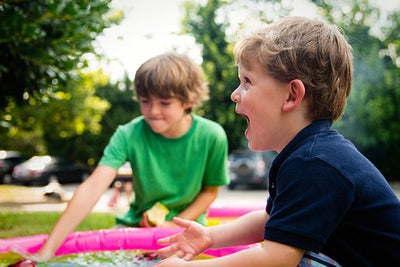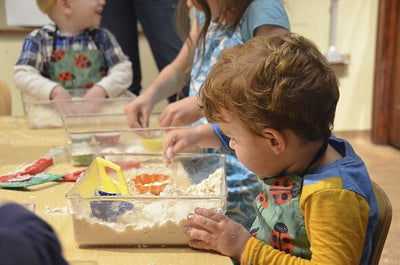Part 4: The Third Stage of Play
Associative Play: 3 - 4 yrs
You've finally made it to the point where your child is interacting with their peers! During associative play, your child is playing near peers and briefly interacts with them but is not maintaining the play interaction or creating an organized play scenario. But.... your child is playing with peers, this is a huge step!
To initiate and briefly engage in play with peers, your child needs to know how to enter play and simple turn-taking behaviors. (Teaching children how to enter play is my favorite topic!)
How to Enter Play
As adults, we may prompt children to join ongoing play by asking, “Can I play with you?” but this is not how children naturally join their peers. Children comment on the ongoing play and then just straight up join in the play activity!
If our goal is for children to play and have the same skills as all the other children, then we need to teach them to interact like the other children do. We do not want to unintentionally set a child up for failure when it comes to playing with their peers. When you ask a Yes/No question like "Can I?" then you are setting yourself up for a response that you are not in control of..... like "No." If your child asks, "Can I play?" then the peer could reasonably respond "No" which would probably be devastating for any child.
Prompting a child to say “Can I play with you?” is like an adult approaching a group and saying “Can I talk with you guys? What are we talking about?” Saying this makes feels very unnatural and creates an awkward situation.
Children develop life-long skills during play, so it makes sense that the same behaviors we expect in interactions as adults we practice as children during play. So next time instead of telling your child to ask, "Can I play with you?" instead use the 3-Stage Model of Social Competence.
The 3-Stage Model of Social Competence describes the three stages that your child uses to enter play. These steps are 1) Surveillance 2) Entry and 3) Maintenance.

3-Stage Model of Social Competence
Stage 1: Surveillance - A child observes the play behavior of peers.
Example: Allie stands near her peers and listens to their conversation. They are talking about dinosaurs. Allie loves dinosaurs and continues to listen.
Stage 2: Entry - A child determines how he/she is going to enter the ongoing play
Example: After listening briefly to her peer’s conversation, Allie thinks up a comment on her peers’ ongoing play. A comment she could use is, “Hey! That’s my favorite dinosaur, too!”
Stage 3: Maintenance - A child determines how he/she is going to enter the ongoing play.
Example: After listening briefly to her peer’s conversation, Allie thinks up a comment on her peers’ ongoing play. A comment she could use is, “Hey! That’s my favorite dinosaur, too!”
Words that teach a student the "Surveillance, Entry, Maintenance Strategy," I use the language and words that make sense to a child.
- Prompt by saying, "Look around, where do you see your friends."
- Ask the child to identify what their friends are playing with and doing.
- Prompt the child to think of something they can say like "I like dinosaurs, too!" or "That's an awesome race track!"

Want to Trade?
Another skill that's important for kiddos when they're starting to play together is trading toys. Sharing is a pretty tough concept whether you are three or a freshman in college (I still have mixed feelings about 'sharing' clothes and food)! A stepping stone to teaching sharing is trading.
Trading is a pretty concrete thing. I get something and you get something, it's an arrangement that we both can agree on. Whether you're teaching your child how to share or ask where the bathroom is, keep in mind to teach your child the language and phrases that children their age typically use. So instead of teaching a 4-year-old to say "Would you mind trading?" or "Would you be open to the idea of considering whether to trade toys?" (which would be cute but peculiar), I focus on the language their peers would be using like "Wanna trade?"
Tips which encourage successful sharing environment (especially between good friends and/or siblings):
1)  Place a visual timer near the children’s play area. If one child would like a turn with an object another child is using, tell them to ask the other child if they can use it for five minutes. Once the child hands the toy over, the adult should set the visual timer to five minutes. When the five-minute bell rings, the child using the item should ask the child who had the item first if they would like the object back.
Place a visual timer near the children’s play area. If one child would like a turn with an object another child is using, tell them to ask the other child if they can use it for five minutes. Once the child hands the toy over, the adult should set the visual timer to five minutes. When the five-minute bell rings, the child using the item should ask the child who had the item first if they would like the object back.
Examples of Visual Timers:
- Time Timer, sold by School Specialty
- Lakeshore Mini Time Timer, sold by Lakeshore Learning Materials
2)  Set up a “Turn List” on the wall for specific “high demand” items. Visual cues is a type of communication style that can work in “high stress” circumstances. When visual cues are used in an organized and fair way, they can successfully encourage positive social play between peers. These high demand items can be a new toy one of the children received for a birthday present, a large gross motor toy such as a trampoline or tricycle, or a favorite pool toy.
Set up a “Turn List” on the wall for specific “high demand” items. Visual cues is a type of communication style that can work in “high stress” circumstances. When visual cues are used in an organized and fair way, they can successfully encourage positive social play between peers. These high demand items can be a new toy one of the children received for a birthday present, a large gross motor toy such as a trampoline or tricycle, or a favorite pool toy.
- To set up a “Turn List” the parent should take a photo of the item and print it out. The parent should also print a picture of each child present.
- Place a piece of paper or a clipboard near the desired object.
- Tape the picture of that object towards the bottom of the clipboard or on the bottom of the piece of paper.
- When a child wants a turn with the item that another child is using, they can place their photo on the clipboard with the corresponding item on it. This action will signal to the child and the supervising adult that the child, whose picture is on the clipboard, would like to use that object when the current child is finished. Facilitating time limits with certain objects is up to the adult supervising.
The Associative Play stage typically lasts from when your child is 3-4 years old. Soon your child will develop more advanced play skills. The next post in this series will describe typical play skills for children ages 4 through 6 years old.
Remember that all children learn differently and at different paces. Development is affected by children’s exposure to a variety of situations. This is a great age to start attending preschools or daycares in your area where children learn to engage in facilitated play experiences and routines.
For ideas on how to support your child in developing age appropriate social skills with family members and peers, use the JDEducational Activity Guide: Level 1: Module 3: My Family; Taking Turns with Loved ones.
About the Authors:
 Jeana Kinne is an Early Childhood Developmental Specialist with a Masters in Education. She currently works with infants and toddlers with special needs and blogs at www.jdeducational.com where she shares tips and tricks regarding child development and answers to commonly asked parenting questions. Jeana created simple and engaging learning activities you can do at home with your children, using items you already have at home. You can find these activities at www.jdeducational.com/collections and follow her on Facebook at JDEducational: Preschool & Kindergarten Readiness.
Jeana Kinne is an Early Childhood Developmental Specialist with a Masters in Education. She currently works with infants and toddlers with special needs and blogs at www.jdeducational.com where she shares tips and tricks regarding child development and answers to commonly asked parenting questions. Jeana created simple and engaging learning activities you can do at home with your children, using items you already have at home. You can find these activities at www.jdeducational.com/collections and follow her on Facebook at JDEducational: Preschool & Kindergarten Readiness.
 Leia Knight is Deaf Educator specialized in Listening and Spoken Language. She developed Language for the Playground to answer the WHY and HOW questions. Why children need social and language skills, why certain skills are important, how to teach these skills, and how these skills affect a child’s functioning in the real-world. Leia discusses strategies, tips and research to answer all your language, listening and social skills questions at languagefortheplayground.com.
Leia Knight is Deaf Educator specialized in Listening and Spoken Language. She developed Language for the Playground to answer the WHY and HOW questions. Why children need social and language skills, why certain skills are important, how to teach these skills, and how these skills affect a child’s functioning in the real-world. Leia discusses strategies, tips and research to answer all your language, listening and social skills questions at languagefortheplayground.com.




